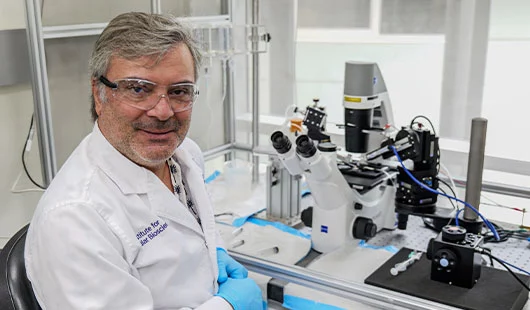Insect venom may seem like an unlikely ally in the discovery of new human pain treatments, but the latest findings into the "unique" way a small ant causes us such agony is a big leap forward – and one that's expected to progress rapidly.
Researchers from the University of Queensland (UQ) have detailed how the toxin from the West African ant (Tetramorium africanum) works, and how its hyperactivity in cellular sodium channels manages to inflict such intense pain on its victims. But by understanding this, the scientists believe there is a path forward to better treatment of targeted pain.
"Venom-derived peptides from ants and related arthropods, like bees and wasps, are a rich and untapped source of interesting molecules that neuroscientists use as tools to understand how ion channel targets operate, and as lead molecules for drug development for neurological disorders such as chronic pain and epilepsy," Dr. Angelo Keramidas, from the UQ Institute for Molecular Bioscience, told New Atlas.

In 2023, Keramidas and his team discovered how neurotoxic molecules from the ant's venom were able to bind to sodium channels within human cells, causing a "cacophony" of unpleasant symptoms including inflammation and excessive sweating.
Now, homing in on the venom peptide Ta3a, and its effects on voltage-gated sodium channels and electrical overstimulation, the researchers have unraveled the mechanism behind the sting that causes such discomfort – which is part of the university's long-term venom research – and takes them one step closer to finding an effective way to block acute and chronic pain signals.
“Using electrophysiology, we were able to see that the toxin binds to the sodium channel and hijacks the channel’s built-in activation mechanism, causing hyperactivity,” Keramidas said. “There was a rush of negative ions attracted to the channel and a repelling of positive ions which caused the hyperactivity of the sodium channel to amplify – a phenomenon we’d never seen before.
“This hyperactivity causes continuous firing of the pain signal, explaining the ferocity of the ant sting. The venom activates multiple channels in the nerve cell membrane, and they remain active for a very long time and can’t be reset. We believe this overstimulation eventually causes numbness at the sting site.”
For years, scientists across the world have been focused on the intricate details of venom, hoping to find a way of turning human pain into gain – and we've covered many of the discoveries. These include looking at the molecules in bee and wasp stings, as well as spider and scorpion toxins.
And while we know there is a connection between the toxins and nerve cells that cause the victim pain and discomfort (or worse), the UQ team has found that not all venom in the animal kingdom is created equal.
"I became more active in venom peptide research as I became more interested in the ion channels that the peptides often target," said Keramidas. "We discovered that venom peptides from ant stings are structurally different than peptides from venoms of other arthropods. The ant venom peptides also affect the ion channels in a way that is unique and even a little bizarre."
In the latest study, the researchers focused on the ion channels, or the voltage-gated sodium channel. This pathway plays a critical role in how pain is felt following a sting or bite.
"This channel is a key molecular mediator of the electrical signaling in the brain and sensory neurons that transmit pain," said Keramidas. "The findings in the new paper has uncovered a mechanism of action that has never been seen before and might be unique to these types of venom peptides."
Much like the human brain, the complexities involved in pain signaling are vast, involve many concurrent factors and are highly personalized. However, understanding pain on a molecular, biochemical level boosts our chances of developing more impactful drugs and therapies that target specific mechanisms – like the overstimulation in those sodium channels.
"Treatment strategies aim to target specific causes of pain, and as there are many causes, there will be more than one precision treatment," Keramidas told New Atlas. "There are, of course, causes of pain that are more common in the community than others, so there will be treatments that benefit most people. For now, we are interested in understanding what is happening at a molecular level. As our understanding develops, that will likely inspire new strategies for pain relief."

And while it might seem like microscopic, painstakingly slow progress, there's good reason to expect this kind of research and drug development to speed up, thanks to technology. After all, the AlphaFold2 artificial intelligence system helped scientists crack a 50-year protein-structure mystery – which earned them this year's Nobel Prize in Chemistry.
According to Keramidas, we're just starting to unlock the huge potential of AI-assisted scientific research and development.
"If AI algorithms can help us redesign natural peptides that produce only the desired effects at the ion channels, then precision treatment for an array of neurological disorders will be achieved more quickly," he added. "This technology has already begun. We will likely see more AI designer drugs, including peptides, in the near future."
The study was published in the Journal of Biological Chemistry.
Source: The University of Queensland





